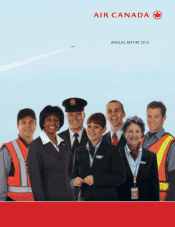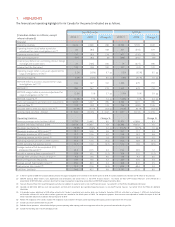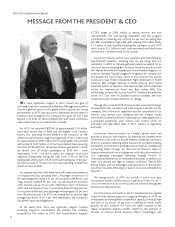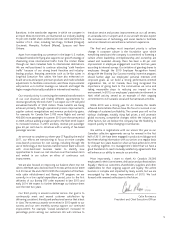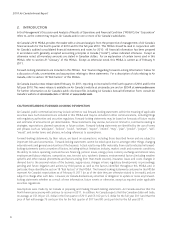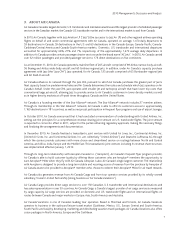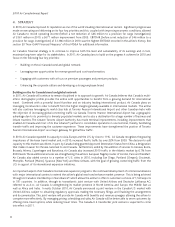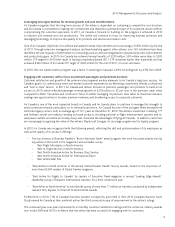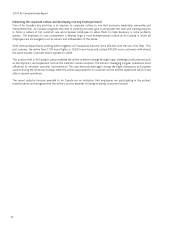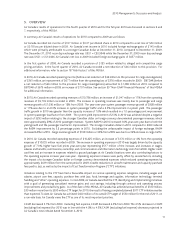Air Canada 2010 Annual Report Download - page 8
Download and view the complete annual report
Please find page 8 of the 2010 Air Canada annual report below. You can navigate through the pages in the report by either clicking on the pages listed below, or by using the keyword search tool below to find specific information within the annual report.2010 Air Canada Annual Report
8
4. STRATEGY
In 2010, Air Canada improved its reputation as one of the world’s leading international air carriers. Significant progress was
made on executing and delivering on its four key priorities and this, coupled with improving economic conditions, allowed
Air Canada to record operating income (before a net reduction of $46 million to a provision for cargo investigations)
of $361 million in 2010, a $677 million improvement from 2009. EBITDAR (before a net reduction of $46 million to a
provision for cargo investigations) of $1,386 million in 2010 was the highest EBITDAR recorded in the airline’s history. See
section 20 “Non-GAAP Financial Measures” of this MD&A for additional information.
Air Canada’s financial strategy is to continue to improve both the level and sustainability of its earnings and, in turn,
maximize long-term value for its stakeholders. In 2011, Air Canada plans to build on the progress it achieved in 2010 and
focus on the following four key priorities:
t Building on the Air Canada brand and global network;
t Leveraging new opportunities for revenue growth and cost transformation;
t Engaging with customers with a focus on premium passengers and premium products;
t Enhancing the corporate culture and developing a strong employee brand.
Building on the Air Canada brand and global network
In 2011, Air Canada will continue to remain disciplined in its approach to growth. Air Canada believes that Canada’s multi-
ethnic demographic profile provides the airline with opportunities to benefit from a growing demand for international
travel. Combined with a powerful brand franchise and an industry leading international product, Air Canada plans on
leveraging its network in order to benefit from the higher margins generally available in international markets. The airline
will also continue leveraging its world class hub at Toronto Pearson International Airport and other Canadian hubs with
the objective of increasing global connecting traffic via Canada. Toronto Pearson International Airport has a geographic
advantage due to its proximity to densely populated markets and is also a destination for a large number of business and
leisure travelers. The Greater Toronto Airport Authority has made terminal improvements, including improvements that
enabled Air Canada and most of its Star Alliance® partners to consolidate operations in one terminal, thereby facilitating
transfer traffic and improving the customer experience. These improvements have strengthened the position of Toronto
Pearson International Airport as a major gateway for global flow traffic.
In 2010, Air Canada expanded its capacity to Asia, Europe and the U.S. by close to 11%. Air Canada recognizes the growing
importance of the Asian travel market and, in 2010, increased Pacific traffic by over 22% from 2009. The decision to add
capacity to this market was driven, in part, by Canada being granted Approved Destination Status from China, a designation
that makes it easier for Chinese nationals to visit Canada. Furthermore, aided by the addition of services to Geneva, Rome,
Brussels, Athens, Copenhagen and Barcelona, Air Canada also increased 2010 traffic in the Atlantic market by 6.7% from
2009 levels. These additional services are strengthening the airline’s European flagship routes of London, Paris and Frankfurt.
Air Canada also added service to a number of U.S. cities in 2010, including San Diego, Portland (Oregon), Cincinnati,
Memphis, Portland (Maine), Syracuse (New York) and New Orleans, with the goal of growing connecting traffic from the
U.S. in support of its international expansion initiatives.
An important aspect of Air Canada’s international expansion program is the continued development of commercial alliances
with major international carriers to extend the airline’s global reach and enhance market presence. This is being achieved
through Air Canada’s membership in Star Alliance® which allows the airline to offer its customers a choice of 1,160 airports
in 181 countries. In addition, through its transatlantic joint venture with United Airlines and Deutsche Lufthansa AG,
referred to as A++, Air Canada is strengthening its market presence in North America and Europe, the Middle East as
well as Africa and India. In early October 2010, Air Canada announced a joint venture in the Canada-U.S. market with
United Airlines, subject to obtaining regulatory approvals, making the necessary filings, and finalizing the arrangements
and documentation. This joint venture will provide Air Canada with benefits and revenue synergies allowing the airline to
compete more effectively. By managing pricing, scheduling and sales, Air Canada will be better able to serve customers by
offering more travel options, while reducing travel times. The Canada-U.S. transborder joint venture is expected to come
into effect in 2011.

